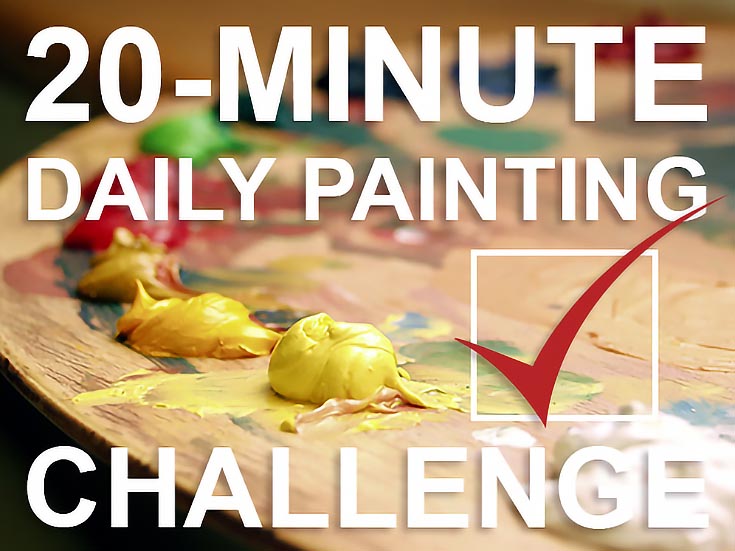
Let’s face it. Most artists can’t afford to be full-time artists. They love to create and they even sell their work, but simply do not earn enough studio income to make quitting their day job feasible.
Many of us also have obligations in addition to a full or part-time job (or two). Even the business side of being a part-time artist can gobble up incredible amounts of time. With all of that going on, how in the world can an artist make time to create?
The problem (at least for me)
I’ve been an oil painter for most of my life. But, I’ve always believed I needed large chunks of time in order to even begin thinking about painting.
• It took time to prepare to paint.
• It took time to paint.
• It took time to clean up afterward.
Two hours was usually the minimum amount of time I felt I could paint and be creative, so whenever I had less than that, I thought it just wasn’t worth the effort.
With a full-time job and a family, my days (and most of my evenings and weekends) simply weren’t available. As a colored pencil portrait artist, there were business details to attend to as well, like contacting new clients, keeping current clients apprised of progress. Marketing. Et cetera, et cetera, et cetera.
In other words, large blocks of time simply were not available for painting. . . and I know many artists working in other mediums who face the same problem.
The challenge
In 2007, I gave myself a personal challenge: paint one ACEO-sized painting every single day (except on Sunday) for an entire year. The purpose was to learn to paint better, more realistic landscapes.
NOTE: ACEOs are a form of miniature art that MUST be exactly 3.5 inches by 2.5 inches in size—learn more about these pocket-sized artworks here.
I also wanted a way to acquire or improve those skills without long investments of time or materials. Painting quickly was the best way to learn and painting small was the best way to maintain a fast painting pace.
Besides, my more cynical side told me, if a little painting didn’t turn out, I could either throw it away or paint over it without guilt.
My results
Interestingly, I didn’t have to go through the entire year before I learned something important: I could accomplish a lot with paint and brush in twenty minutes or less.
Many times I found myself at the end of the day with twenty minutes left and I was just starting to paint the day’s ACEO. I wish I could say I succeeded in meeting my goal every day. . . but unfortunately, I missed some days.
That said, I did succeed on a lot of days. And I discovered I could do a decent, little painting in twenty minutes or less. All I had to do was get started. And as my ACEOs accumulated, I began to wonder what kind of progress I could make on larger paintings by putting in “just twenty minutes a day.”
The answer? More than I previously thought possible.
I found that the most difficult part of painting—or any task, for that matter—is getting started. Maybe that’s a problem for you, too.
Painting an ACEO a day taught me was that all I had to do to get started was to promise myself that I only had to paint twenty minutes. It was a lot easier to make a start if I knew I could stop in a quarter hour and have met my goal for the day.
The neat thing was that once I started painting, it was easy to work past twenty minutes. Even on those days when I didn’t think I had “enough time to paint.” And I finished larger paintings more quickly than if I’d waited for days (or maybe weeks) for just the right amount of uninterrupted studio time.
It got to the point at which I could work on paintings in five- and ten-minute stretches if that was all the time I had. That allowed me to paint almost every day no matter what else was on my schedule. And that was extremely liberating!
But wait, there’s more. . .
Do you remember one of the reasons I listed as why I chose to do this 20-minute per day ACEO challenge? It was so I wouldn’t feel guilty about trashing bad paintings. Now guess how many I actually threw away.
That’s right. Zero.
There was something redeeming about each and every ACEO I painted. Plus, about half of them sold within a year (how’s that for incentive!)
Like most things in life, this painting challenge reaped benefits in more ways than just learning how to paint better landscapes. Yes, I did learn that, but there was another, much more important lesson buried in all those little, bitty paintings.
I found the solution to my problem of “never having enough time.”
And so that’s why I’m ending this post with a challenge for YOU. :)
Set a goal to paint 20 minutes a day. Paint on paper. Paint small. Figure out how you’ll do it, and set a goal for how long you’ll stick with it: a month, a year. . . you decide. Just DO it.
I think you’ll be amazed both at how it pushes you to re-evaluate your use of time AND makes you a better painter—in just 20 minutes a day.
This post may contain affiliate links.
